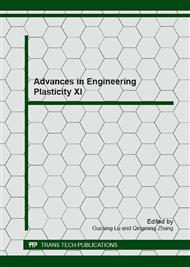p.247
p.250
p.254
p.263
p.267
p.271
p.275
p.279
p.284
Development of Electromagnetic-Mechanical Coupled FE-Model for Thin Aluminum Plate Forming Using Electromagnetic Force
Abstract:
The high cost of manufacturing and manufacturing time is required for preliminary experiment by manufacturing various type of coil every time for the forming of the required shape, it is essentially required to develop the coil design technology using a FEM. Thus, in order to form the required shape, it is important to design the coil using a FEM and predict the final forming product. Therefore, in this study developed electro-mechanical coupled FE-model for thin aluminum plate forming using electromagnetic force. In order to carry out this, magnetic pulse forming was carried by electromagnetic forming system total energy of 24kJ. Peck current and discharge speed acquired through magnetic pulse forming experiment using Rogowski current waveform transducer was used as input data in electromagnetic FE-model. Then, calculated electromagnetic force between forming coil and workpiece through the developed electromagnetic model was inputted as a load of mechanical FE-model for the prediction of thin aluminum plate forming shape. As results, developed electromagnetic-mechanical coupled model shall be able to be usefully used when designing the forming coil to secure the required forming shape later.
Info:
Periodical:
Pages:
267-270
Citation:
Online since:
January 2013
Authors:
Price:
Сopyright:
© 2013 Trans Tech Publications Ltd. All Rights Reserved
Share:
Citation:


